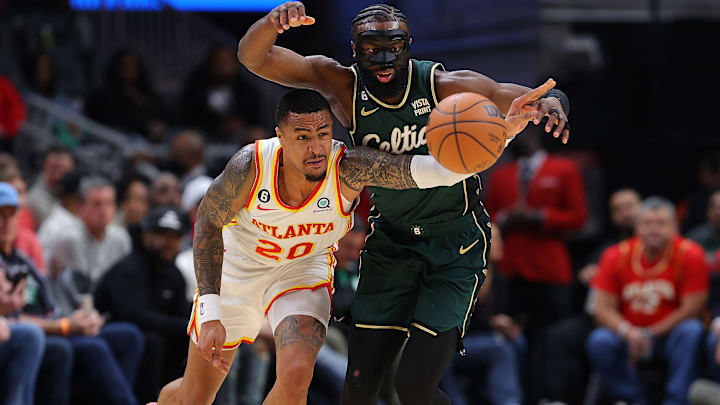The small forward who can get to the next level by cutting their turnovers: Jaylen Brown
Jaylen Brown is the patron saint of the eye test vs. analytics debate, and his assist-to-turnover ratio is the primary factor. Most advanced all-in-one advanced metrics paint Brown as a good, but not All-Star caliber player. Meanwhile, your average NBA reporter, former player with a microphone, and sports debater talk about Brown as an All-NBA level contributor and ask if he and Jayson Tatum are the best duo in the league. So why is there such a divide between what people see and what the math says?
The easy answer is Brown is a high-volume scorer, and points are the one stat that even the mathematically allergic can consume. However, Brown’s scoring, while probably not quite as impactful as the raw figure would suggest, is still pretty dang impressive. 26.6 points per game on league-average efficiency is incredibly valuable, no matter what effective field goal truthers tell you. The problem Brown faces is he gives away far too many points through his turnovers.
For a small forward, Brown’s per-36-minute assist-to-turnover points added was the 23rd worst (plus-1.3), but he also spent 39 percent of his minutes at shooting guard, where he would have had the sixth worst figure for any player to play over 1,000 minutes. Fixating on Brown’s positional distinction also misses a crucial point. He is one of the highest-usage players in the sport, and the offensive responsibility Brown shoulders demands better production.
Out of the 70 qualified players to average 20 or more field goal attempts per 100 possessions (Brown ranked sixth at 28.0), Brown’s 1.175 assist-to-turnover ratio was the 11th-lowest, and only four non-centers or power forwards produced a lower figure. High-usage players either need to be unconscionably efficient as scorers (Joel Embiid) or chip in enough assists to offset their turnovers (Trae Young) to be true star-level offensive contributors (some do both).
Last season, Brown averaged 26.7 points per 36 minutes and added another 1.3 assist-to-turnover points added to produce a tidy 28.0 points per 36 minutes. Meanwhile, Julius Randle scored 25.5 points per 36 minutes and added another 3.3 assist-to-turnover points added for a total of 28.8 points per 36 minutes. There’s a very strong argument that Randle had a better offensive season than Brown last season, but bringing that take to First Take would probably get you laughed off the set.
The easiest avenue for Brown to improve his overall offensive impact is to trim his lost ball turnovers. The running joke that Brown doesn’t have a left hand is somewhat overblown, but his leaky handle is preventing his impressive scoring from being as impactful as it should be. With the Celtics’ additions of Kristaps Porzingis and Jrue Holiday, many of Brown’s issues may be solved by impeccable roster construction. He’ll have more space to operate, more firepower to kick out to, and less ball-handling responsibility. The end result should be fewer turnovers and more assists. However, if Brown doesn’t see real growth in these areas, we’ll just have to admit that he’s as frustrating as he is talented.
